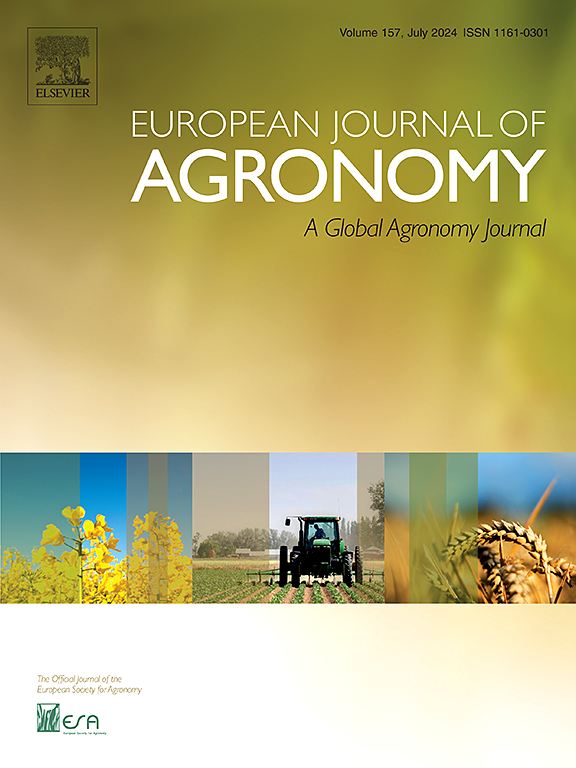Accurate estimation of winter-wheat leaf water content using continuous wavelet transform-based hyperspectral combined with thermal infrared on a UAV platform
IF 4.5
1区 农林科学
Q1 AGRONOMY
引用次数: 0
Abstract
Timely and accurate assessment of crop water status using unmanned aerial vehicle (UAV) imagery is helpful for precision irrigation and field management. The aim of this study is to investigate the application potential of continuous wavelet transform (CWT)-based hyperspectral combined with thermal infrared image data for the estimation of leaf water content (LWC) in winter wheat. This study evaluates the performance of convolutional neural networks (CNN) for feature extraction and long short-term memory (LSTM) networks for sequential data processing in LWC estimation. A UAV platform carrying hyperspectral and thermal infrared sensors was used to collect high spatial resolution images of winter wheat under different water treatments over two years. The LWC was collected simultaneously. The original (OR) and CWT-transformed canopy spectral and textural features, as well as canopy temperature indicators, were extracted from the UAV-based images. On this basis, the LWC estimation model was established using the CNN and LSTM model. The results showed that the combination of thermal features with spectral and texture features significantly improves model performance compared to models built on a single data. The CWT-transformed spectral features improved LWC estimation compared to the original spectrum, with the third scale (CWT3) yielding the best results. Moreover, the CWT-transformed texture at multi-decomposition scales proved to be effective for estimating LWC. Compared to other models, the LSTM model (T-STCWT3-LSTM), built by thermal feature fusion with CWT3-based spectral and texture features, achieved the best LWC estimation results, with R2 of 0.827 and 0.836, RMSE of 2.575 % and 1.822 %, and MAE of 2.041 % and 1.434 % for 2022 and 2023, respectively. In addition, the robustness of the T-STCWT3-LSTM model was successfully verified at different growth stages. Overall, the CWT technique and multi-feature fusion approach provide a valuable technical reference for real-time crop water status monitoring, supporting improved precision irrigation practices and sustainable crop management.
基于连续小波变换的高光谱结合热红外在无人机平台上对冬小麦叶片含水量的精确估计
利用无人机(UAV)图像及时准确地评估作物水分状况,有助于精准灌溉和田间管理。本研究旨在探讨基于连续小波变换(CWT)的高光谱结合热红外图像数据在冬小麦叶片含水量估算中的应用潜力。本研究评估了卷积神经网络(CNN)在LWC估计中用于特征提取和长短期记忆(LSTM)网络用于顺序数据处理的性能。利用搭载高光谱和热红外传感器的无人机平台,对不同水分处理下的冬小麦进行了两年多的高空间分辨率图像采集。LWC是同时收集的。从无人机图像中提取原始(OR)和cwt变换后的冠层光谱和纹理特征以及冠层温度指标。在此基础上,利用CNN和LSTM模型建立LWC估计模型。结果表明,与单一数据模型相比,热特征与光谱和纹理特征的结合显著提高了模型的性能。与原始光谱相比,cwt变换后的光谱特征改善了LWC估计,其中第三尺度(CWT3)的结果最好。此外,在多分解尺度下,cwt变换后的纹理对LWC的估计是有效的。与其他模型相比,基于cwt3的光谱和纹理特征与热特征融合构建的LSTM模型(T-STCWT3-LSTM)的LWC估计效果最好,2022年和2023年的R2分别为0.827和0.836,RMSE分别为2.575 %和1.822 %,MAE分别为2.041 %和1.434 %。此外,在不同生长阶段成功验证了T-STCWT3-LSTM模型的鲁棒性。综上所述,CWT技术和多特征融合方法为作物水分状况实时监测提供了有价值的技术参考,为改进精准灌溉实践和作物可持续管理提供了支持。
本文章由计算机程序翻译,如有差异,请以英文原文为准。
求助全文
约1分钟内获得全文
求助全文
来源期刊

European Journal of Agronomy
农林科学-农艺学
CiteScore
8.30
自引率
7.70%
发文量
187
审稿时长
4.5 months
期刊介绍:
The European Journal of Agronomy, the official journal of the European Society for Agronomy, publishes original research papers reporting experimental and theoretical contributions to field-based agronomy and crop science. The journal will consider research at the field level for agricultural, horticultural and tree crops, that uses comprehensive and explanatory approaches. The EJA covers the following topics:
crop physiology
crop production and management including irrigation, fertilization and soil management
agroclimatology and modelling
plant-soil relationships
crop quality and post-harvest physiology
farming and cropping systems
agroecosystems and the environment
crop-weed interactions and management
organic farming
horticultural crops
papers from the European Society for Agronomy bi-annual meetings
In determining the suitability of submitted articles for publication, particular scrutiny is placed on the degree of novelty and significance of the research and the extent to which it adds to existing knowledge in agronomy.
 求助内容:
求助内容: 应助结果提醒方式:
应助结果提醒方式:


